Hunting for the first luminous quasars
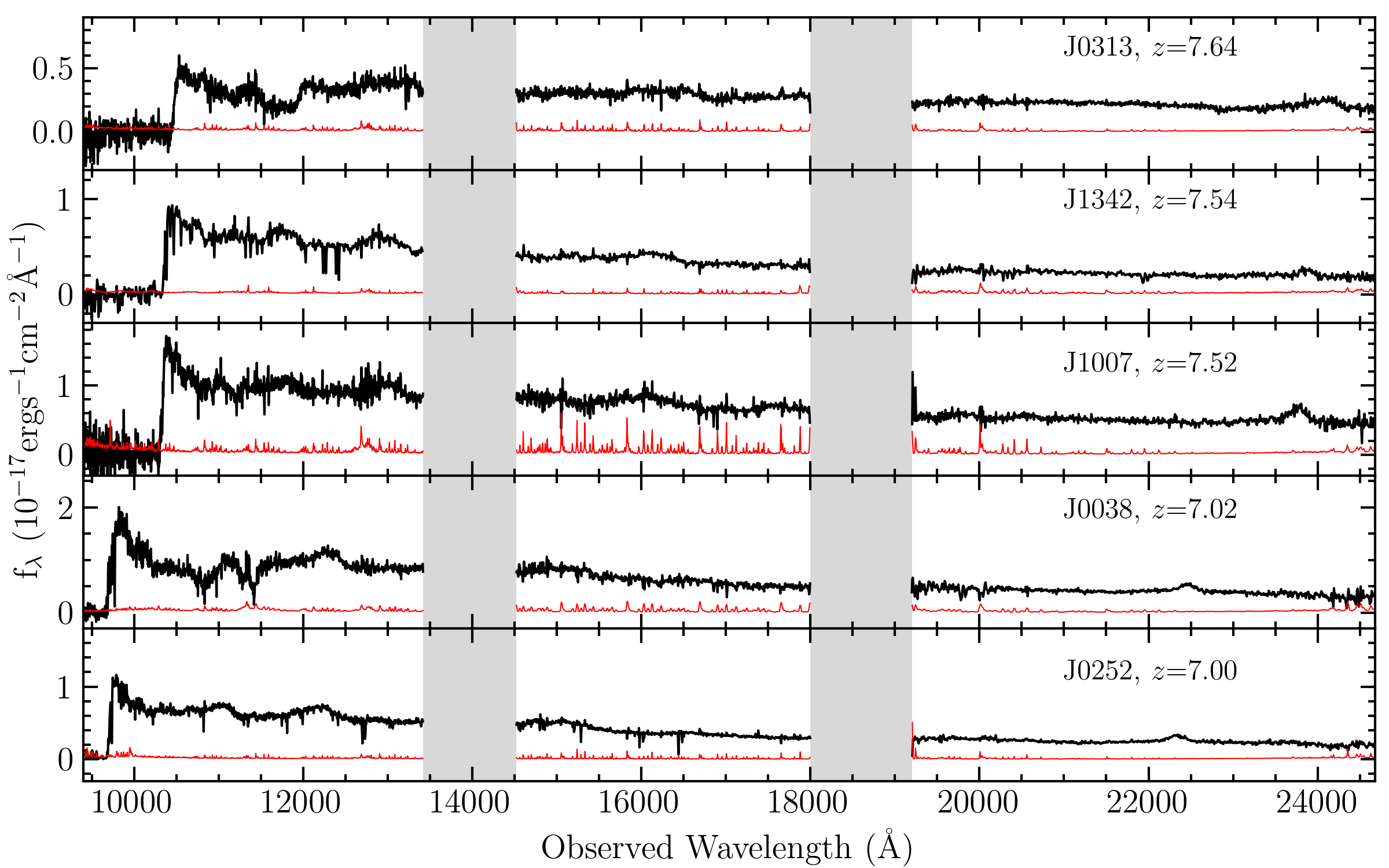 High redshift quasars are important tracers to study the accretion history of supermassive
black holes (SMBHs), early structure formation and the history of cosmic reionization.
However, high redshift quasar searches are extremely challenging due to their low spatial density
and a high rate of contamination from Galactic cool dwarfs. In the past several years,
we have constructed the first large quasar sample at z>6.5, deep into the epoch of reionization,
using a combination of optical and infrared wide-field imaging. We discovered about
50 quasars at z>6.5, 5 quasars at z>7, including the most distant quasar
(J0313 at z=7.64) known to date,
the first monster black hole awared a Hawaiian name
(Pōniuāʻena at z=7.52) and
the most distant gravitationally lensed quasar
(J0439 at z=6.51).
The plot in the left shows five z>7 quasars discovered by our team. The following table lists all eight z>7 quasars known to date.
High redshift quasars are important tracers to study the accretion history of supermassive
black holes (SMBHs), early structure formation and the history of cosmic reionization.
However, high redshift quasar searches are extremely challenging due to their low spatial density
and a high rate of contamination from Galactic cool dwarfs. In the past several years,
we have constructed the first large quasar sample at z>6.5, deep into the epoch of reionization,
using a combination of optical and infrared wide-field imaging. We discovered about
50 quasars at z>6.5, 5 quasars at z>7, including the most distant quasar
(J0313 at z=7.64) known to date,
the first monster black hole awared a Hawaiian name
(Pōniuāʻena at z=7.52) and
the most distant gravitationally lensed quasar
(J0439 at z=6.51).
The plot in the left shows five z>7 quasars discovered by our team. The following table lists all eight z>7 quasars known to date.
| Name | RA | DEC | Redshift | M1450 | MBH(109M⊙) | Discovery Reference |
|---|---|---|---|---|---|---|
| J031343.84−180636.4 | 03:13:43.839 | −18:06:36.40 | 7.6423 | −26.13 | 1.60 | Wang+2021 |
| J134208.11+092838.6 | 13:42:08.110 | +09:28:38.61 | 7.5413 | −26.76 | 0.78 | Banados+2018 |
| J100758.26+211529.2 | 10:07:58.264 | +21:15:29.21 | 7.5149 | −26.66 | 1.50 | Yang+2020 |
| J112001.48+064124.3 | 11:20:01.480 | +06:41:24.30 | 7.0851 | −26.60 | 2.00 | Mortlock+2011 |
| J124353.93+010038.5 | 12:43:53.93 | +01:00:38.50 | 7.07 | −24.13 | 0.33 | Matsuoka+2019 |
| J003836.10−152723.6 | 00:38:36.097 | −15:27:23.64 | 7.021 | −27.10 | 1.33 | Wang+2018 |
| J235646.33+001747.3 | 23:56:46.33 | +00:17:47.30 | 7.01 | −25.31 | -- | Matsuoka+2019 |
| J025216.64−050331.8 | 02:52:16.640 | −05:03:31.81 | 7.00 | −26.63 | 1.39 | Yang+2018 |
- Wang, F., Fan, X., Yang, J., et al. First Discoveries of z>6 Quasars with the DECam Legacy Survey and UKIRT Hemisphere Survey. 2017, ApJ, 839, 27.
- Wang, F., Yang, J., Fan, X., et al. The Discovery of A Luminous Broad Absorption Line Quasar at A Redshift of 7.02. 2018, ApJL, 869, L9.
- Wang, F., Yang, J., Fan, X., et al. Exploring Reionization-Era Quasars III: Discovery of 16 Quasars at 6.4≲z≲6.9 with DESI Legacy Imaging Surveys and UKIRT Hemisphere Survey and Quasar Luminosity Function at z~6.7. 2019, ApJ, 884, 30.
- Yang, J., Wang, F., Fan, X., et al. Exploring Reionization-era Quasars. IV. Discovery of Six New z≳6.5 Quasars with DES, VHS, and unWISE Photometry. 2019, AJ, 157, 236.
- Fan, X., Wang, F., Yang, J., et al. The Discovery of a Gravitationally Lensed Quasar at z = 6.51. 2019, ApJL, 870, L11.
- Yang, J., Wang, F., Fan, X., et al. Pōniuāʻena: A Luminous z=7.5 Quasar Hosting a 1.5 Billion Solar Mass Black Hole. 2020, ApJL, 897, L14.
- Wang, F., Yang, J., Fan, X., et al. A Luminous Quasar at Redshift 7.642. 2021, ApJL, 907, L1.
The primordial environment of quasars
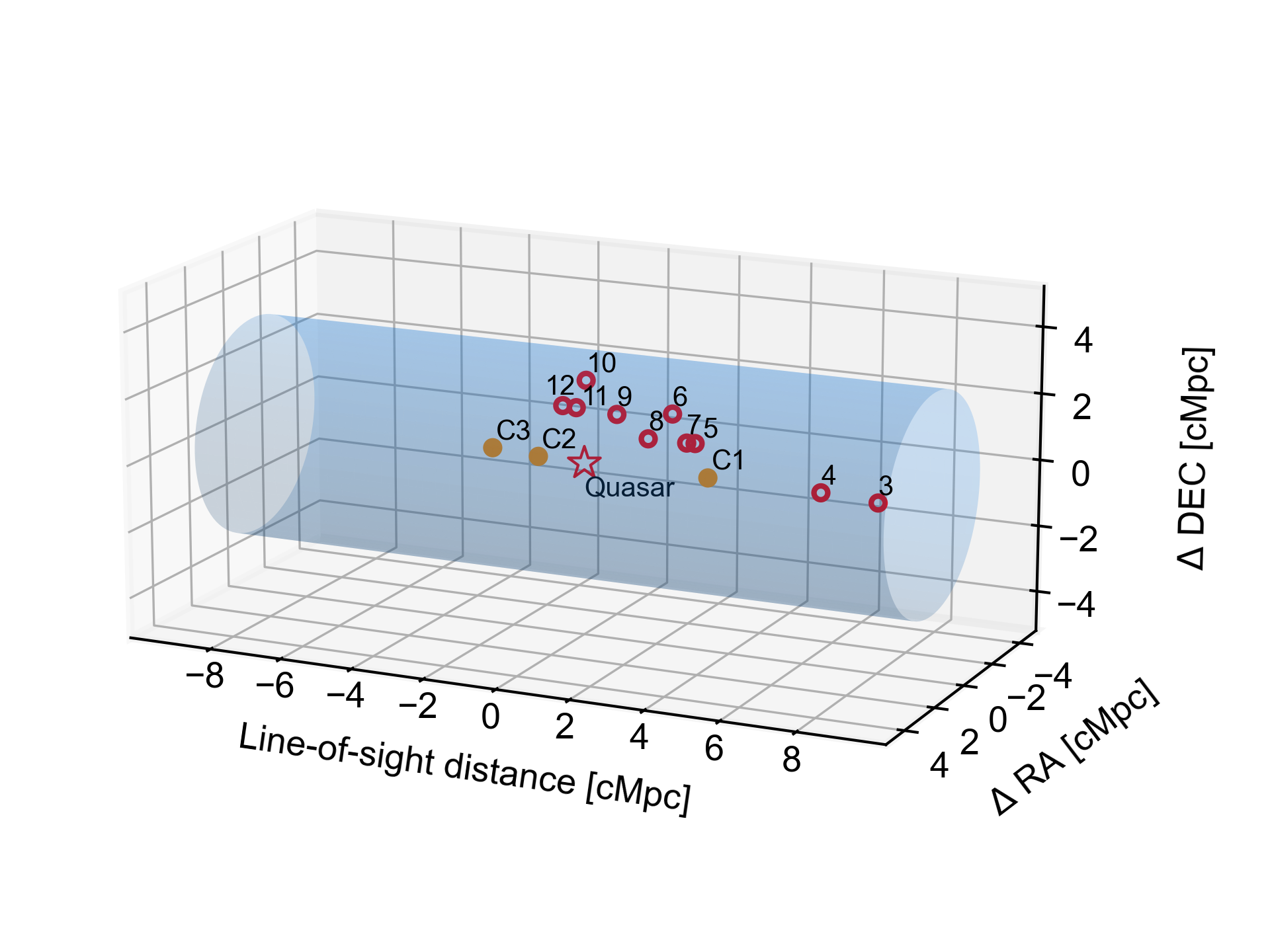 Theoretical models predict that distant quasars are hosted by massive dark matter halos and should act as signposts for protoclusters in the young Universe (see the Figure in the right).
Indeed, many studies have shown that the most luminous quasars at intermediate redshifts preferentially reside within overdensities of galaxies.
In particular, one of the most massive protoclusters known at z~2 is traced by a quasar quartet (Hennawi et al. 2015), implying a physical connection between
quasar activity and the locations of the largest mass concentrations. Nevertheless, extensive searching have not firmly confirmed a single protocluster
associated with quasar activity in the Epoch of Reionization, key epoch for understanding the growth of the earliest supermassive black holes (SMBHs),
casting a veil over our understanding of quasar formation in its cosmological context. I am leading a large program to perform spectroscopic survey of quasars
at z>6.5 with JWST/NIRCamd (see HERE for more details) and to construct a deep narrow band imaging
survey quasars at z=6.6 with Magellan/IMACS and Subaru/HSC. These observations will allow us to identify the distant protoclusters and
lead to a definitive answer to the long-standing open question:
whether the most massive SMBHs inhabit large overdensities of galaxies and reside in the most biased dark matter halos.
Theoretical models predict that distant quasars are hosted by massive dark matter halos and should act as signposts for protoclusters in the young Universe (see the Figure in the right).
Indeed, many studies have shown that the most luminous quasars at intermediate redshifts preferentially reside within overdensities of galaxies.
In particular, one of the most massive protoclusters known at z~2 is traced by a quasar quartet (Hennawi et al. 2015), implying a physical connection between
quasar activity and the locations of the largest mass concentrations. Nevertheless, extensive searching have not firmly confirmed a single protocluster
associated with quasar activity in the Epoch of Reionization, key epoch for understanding the growth of the earliest supermassive black holes (SMBHs),
casting a veil over our understanding of quasar formation in its cosmological context. I am leading a large program to perform spectroscopic survey of quasars
at z>6.5 with JWST/NIRCamd (see HERE for more details) and to construct a deep narrow band imaging
survey quasars at z=6.6 with Magellan/IMACS and Subaru/HSC. These observations will allow us to identify the distant protoclusters and
lead to a definitive answer to the long-standing open question:
whether the most massive SMBHs inhabit large overdensities of galaxies and reside in the most biased dark matter halos.
- Wang, F., Yang, J., Hennawi, J., et al. ASPIRE: JWST Reveals a Filamentary Structure around a z = 6.61 Quasar. 2023, ApJL, 951, L4.
- Champagne, J., Casey, C., Finkelstein, S., et al. A Mixture of LBG Overdensities in the Fields of Three 6 < z < 7 Quasars: Implications for the Robustness of Photometric Selection. 2023, ApJ, 952, 99.
The formation of the earliest SMBHs
Quasars, the most luminous type of active galactic nuclei (AGN), are believed to be powered by accreting supermassive black holes (SMBHs). The continuum and line emissions from luminous quasars, over a large wavelength range, from optical-infrared to X-ray, carry crucial insights into the accrection and growth of the central SMBHs. We are performing a Chandra X-ray survey (a large program with 710 ks approved observation time) of the first uniform and complete sample of luminous quasars at z>6.5. Together with quasar luminosity function and black hole mass function that we are measuring from deep optical-to-infrared observations, the Chandra X-ray observations will provide key constraints to the formation and growth history of the earliest SMBHs. The left figure shows the growth tracks of the highest redshift quasars. The growth of these early SMBHs is limited by the available accretion time. In order to explain the existence of these SMBHs, theoretical models have to invoke either super-Eddington accretion process and/or a massive seed black hole. our measurements of the hard X-ray spectral slope with a pilot Chandra program, which suggests the earliest SMBHs accrecting at the Eddington limit, consistent with the Eddington ratio measured from infrared spectroscopy. The Chandra large program newly approved in Cycle 22, combined with the infrared spectroscopy of a larger sample will allow us to carry out the first statistical measurement of X-ray properties of z>6.5 quasars, to probe the evolution of X-ray slope, spectral energy distribution and accretion rate of early quasars.


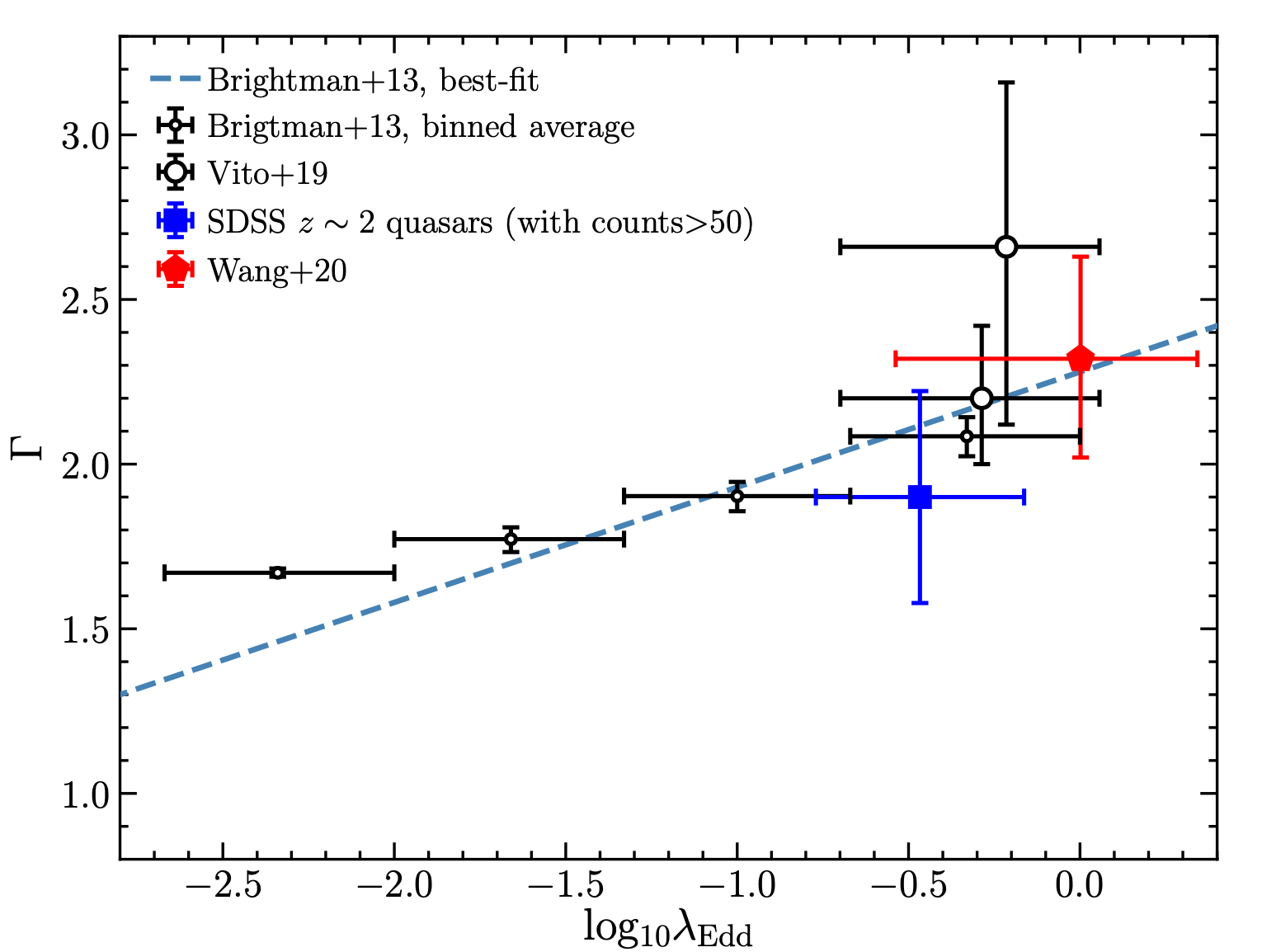
- Yang, J., Wang, F., Fan, X., et al. Pōniuāʻena: A Luminous z=7.5 Quasar Hosting a 1.5 Billion Solar Mass Black Hole. 2020, ApJL, 897, L14.
- Wang, F., Yang, J., Fan, X., et al. A Luminous Quasar at Redshift 7.642. 2021, ApJL, 907, L1.
- Wang, F., Fan, X., Yang, J., et al. Revealing the Accretion Physics of Supermassive Black Holes at Redshift z~7 with Chandra and Infrared Observations. 2021, ApJ, 908, 53
- Yang, J., Wang, F., Fan, X., et al. ASPIRE: A First Look at the Rest-frame Optical Spectra of z > 6.5 Quasars Using JWST. 2023, ApJ, 951, L5
Co-evolution of the earliest SMBHs and their host galaxies
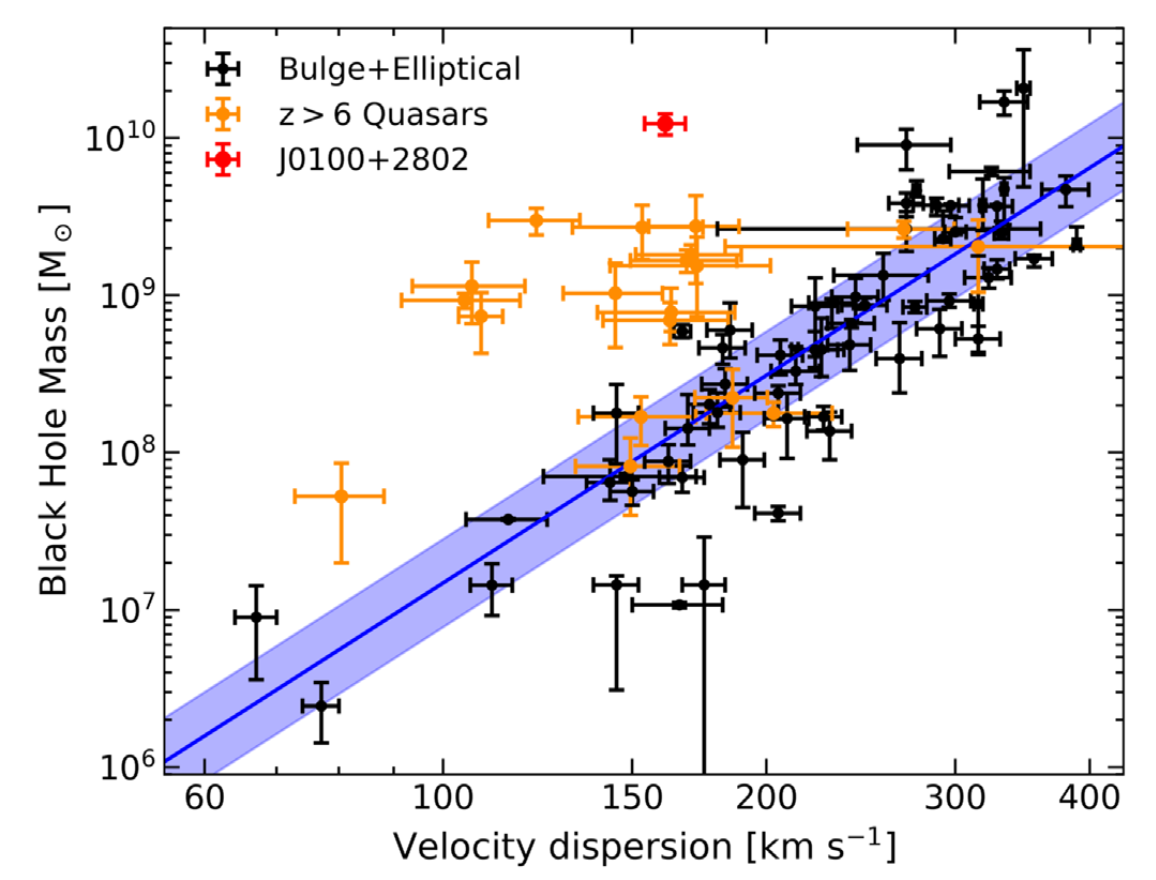 Imaging quasar host galaxies allows us to probe whether the fast SMBH growth co-evolve with the early assembly of massive galaxies.
We are performing a systematic study of quasar host galaxies in the early Universe by targeting the [CII] 158μm emission line
and dust continuum in a sample of ~30 quasars at z>6.5 with ALMA and NOEMA.
In addition, we are also carrying out spatially resolved ALMA observations of [CII] emission line and CO molecular emission lines
of quasar host galaxies to study the dynamical properties. By combing with the black hole masses measured from near-infrared spectroscopy,
we will investigate whether the earliest SMBHs co-evolve with their host galaxies.
Moreover, we are also observing multiple CO molecular emission lines,
[CI] atomic emission line and water lines of the sub-millimeter bright quasars to investigate the gas exciations in the quasar
host galaxies.
Imaging quasar host galaxies allows us to probe whether the fast SMBH growth co-evolve with the early assembly of massive galaxies.
We are performing a systematic study of quasar host galaxies in the early Universe by targeting the [CII] 158μm emission line
and dust continuum in a sample of ~30 quasars at z>6.5 with ALMA and NOEMA.
In addition, we are also carrying out spatially resolved ALMA observations of [CII] emission line and CO molecular emission lines
of quasar host galaxies to study the dynamical properties. By combing with the black hole masses measured from near-infrared spectroscopy,
we will investigate whether the earliest SMBHs co-evolve with their host galaxies.
Moreover, we are also observing multiple CO molecular emission lines,
[CI] atomic emission line and water lines of the sub-millimeter bright quasars to investigate the gas exciations in the quasar
host galaxies.
- Wang, F., Wang, R., Fan, X., et al. Spatially Resolved Interstellar Medium and Highly Excited Dense Molecular Gas in the Most Luminous Quasar at z=6.327 2020, ApJ, 896, 23
- Yang, J., Venemans, B., Wang, F., et al. Far-infrared Properties of the Bright, Gravitationally Lensed Quasar J0439+1634 at z=6.5. 2020, ApJ, 880, 153.
Cosmic reionization history
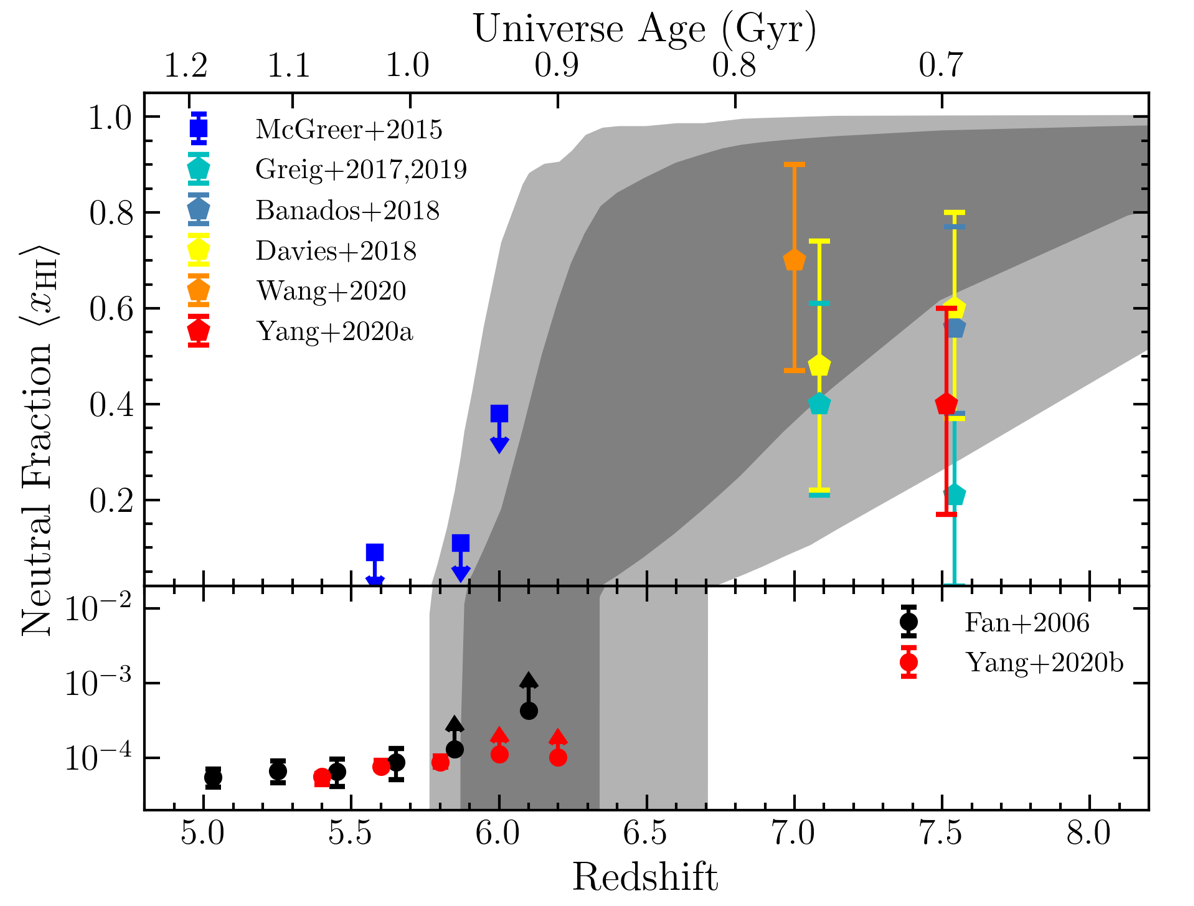 Although many distinct observables have limited the the peak of reionization activity at redshifts
6≲z≲10, the onset and duration of reionization is still poorly constrained. During reionization,
neutral hydrogen in the intergalactic medium (IGM) can produce a damped absorption feature at rest-frame wavelengths redward
of the Lyα line, known as an IGM damping wing.
We are collecting high quality optical to near infrared (NIR) spectroscopy for the newly constructed quasar
sample in the epoch of reionization. This dedicated dataset will enable us, to take a systematic damping wing analysis and
to accurately measure the evolution of IGM neutral fraction with cosmic time.
Combine the damping wing analyses with current various
measurements of neutral fraction, we expect to obtain the best constraints to date on the duration
and the shape of the cosmic reionization. The left graphic shows our current measurements of the IGM neutral fraction using
various quasar absorption techniques (black and red points denote optical depth measurements from Lyα forest, blue squares
denote dark pixel technique, and all the other points represent damp wing measurements).
Although many distinct observables have limited the the peak of reionization activity at redshifts
6≲z≲10, the onset and duration of reionization is still poorly constrained. During reionization,
neutral hydrogen in the intergalactic medium (IGM) can produce a damped absorption feature at rest-frame wavelengths redward
of the Lyα line, known as an IGM damping wing.
We are collecting high quality optical to near infrared (NIR) spectroscopy for the newly constructed quasar
sample in the epoch of reionization. This dedicated dataset will enable us, to take a systematic damping wing analysis and
to accurately measure the evolution of IGM neutral fraction with cosmic time.
Combine the damping wing analyses with current various
measurements of neutral fraction, we expect to obtain the best constraints to date on the duration
and the shape of the cosmic reionization. The left graphic shows our current measurements of the IGM neutral fraction using
various quasar absorption techniques (black and red points denote optical depth measurements from Lyα forest, blue squares
denote dark pixel technique, and all the other points represent damp wing measurements).
- Wang, F., Davies, F.~B., Yang, J., et al. A Significantly Neutral Intergalactic Medium Around the Luminous z=7 Quasar J0252-0503. 2020, ApJ, 896, 23
- Yang, J., Wang, F., Fan, X., et al. Measurements of the z~6 Intergalactic Medium Optical Depth and Transmission Spikes Using a New z>6.3 Quasar Sample. 2020, ApJ, 904, 26.
- Yang, J., Wang, F., Fan, X., et al. Pōniuāʻena: A Luminous z=7.5 Quasar Hosting a 1.5 Billion Solar Mass Black Hole. 2020, ApJL, 897, L14.
Metal content in the early universe
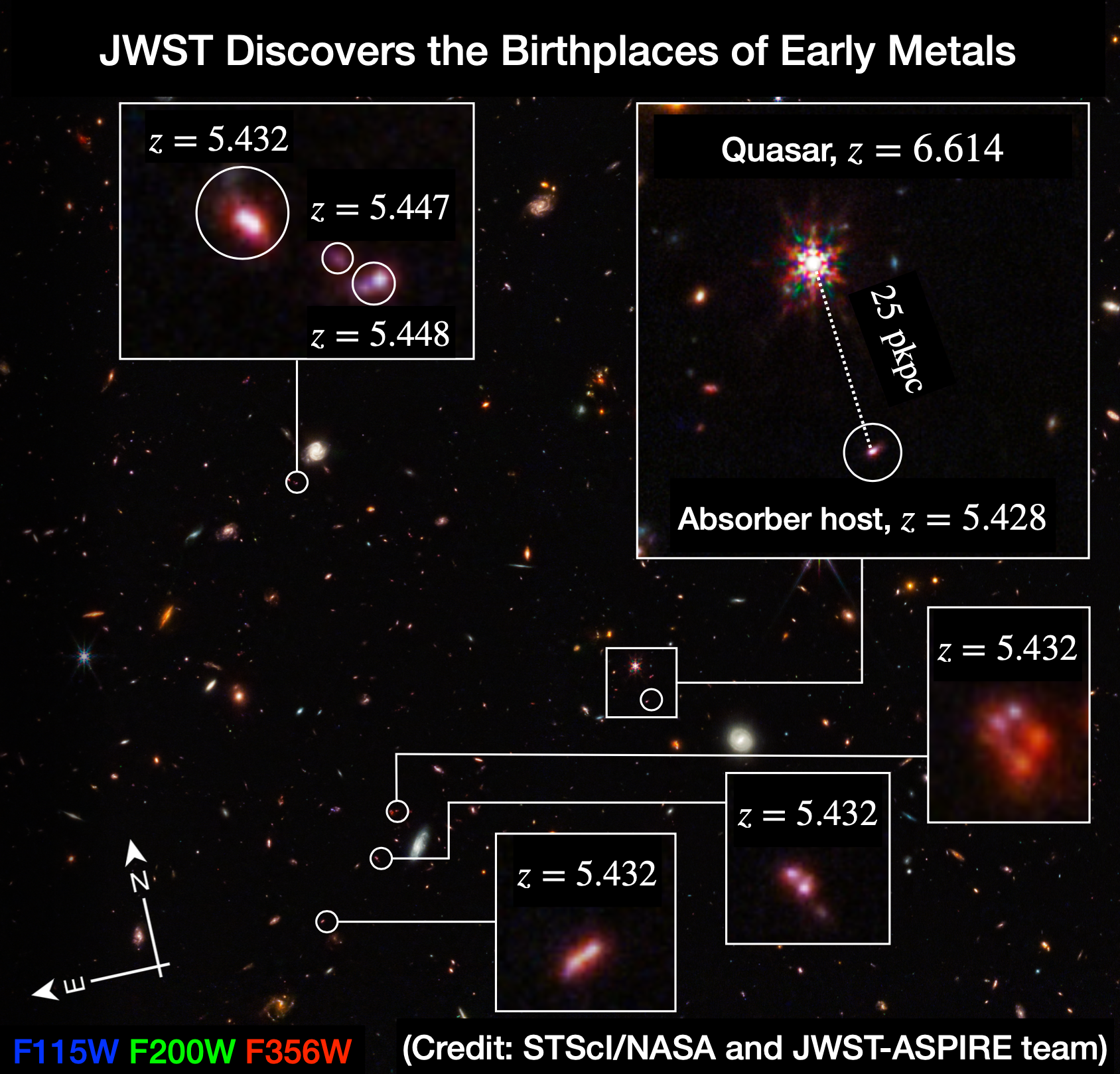 The circumgalactic medium (CGM) metal absorption systems are unique probes of galactic feedback and metal enrichment. However, very few metal absorbers at z>5
have associated galaxy detections (see the Figure in the right), limiting our understanding of the metal enrichment in the young Universe. We are searching for
strong metal absorbers at very high redshifts from quasar spectroscopy and identifying the host galaxies of these metal absorbers with JWST.
In addition to the metals in CGM, the metal content in the intergalactic medium (IGM) at the highest redshifts provides a window into the physics of cosmic reionization.
The smoking gun of reionization would be a transition from weak high-ionization lines to a `forest' of low-ionization metal absorbers. Therefore, we are performing
very deep absorption spectroscopy of z>7 quasars to search for those metal forest and to map the history of cosmic reionization and the earliest metal enrichment.
The circumgalactic medium (CGM) metal absorption systems are unique probes of galactic feedback and metal enrichment. However, very few metal absorbers at z>5
have associated galaxy detections (see the Figure in the right), limiting our understanding of the metal enrichment in the young Universe. We are searching for
strong metal absorbers at very high redshifts from quasar spectroscopy and identifying the host galaxies of these metal absorbers with JWST.
In addition to the metals in CGM, the metal content in the intergalactic medium (IGM) at the highest redshifts provides a window into the physics of cosmic reionization.
The smoking gun of reionization would be a transition from weak high-ionization lines to a `forest' of low-ionization metal absorbers. Therefore, we are performing
very deep absorption spectroscopy of z>7 quasars to search for those metal forest and to map the history of cosmic reionization and the earliest metal enrichment.
- Wang, F., Wu, X. B., Fan, X., et al. An Ultra-luminous Quasar at z=5.363 with a Ten Billion Solar Mass Black Hole and a Metal-rich DLA at z∼5. 2015, ApJL, 807, L9
- Zou, S., Jiang, L., Shen, Y., et al. Strong Mg II and Fe II Absorbers at 2.2 < z < 6.0. 2021, ApJ, 906, 32
- Hennawi, J., Davies, F., Wang, F., et al. Probing reionization and early cosmic enrichment with the Mg II forest. 2021, MNRAS, 506, 2963
- Wu, Y., Wang, F., Cai, Z., et al. ASPIRE: JWST Discovers an Overdensity around a Metal Absorption-selected Galaxy at z~5.5. 2023, ApJL, 956, L40
- Tie, S., Hennawi, J., Wang, F., et al. First measurement of the Mg II forest correlation function in the Epoch of Reionization. 2023, submitted to MNRAS